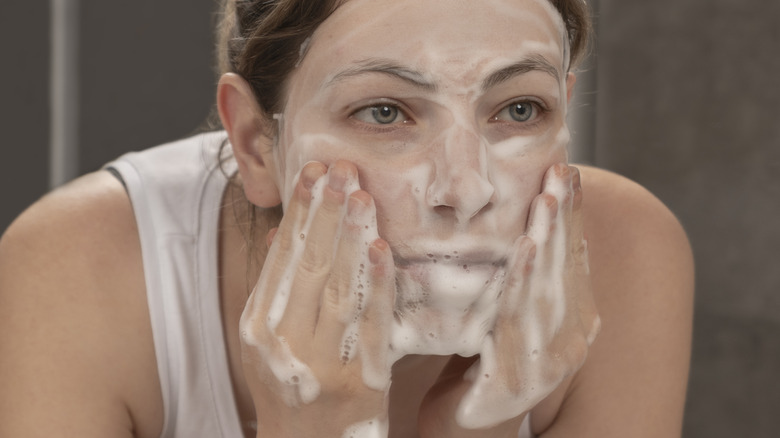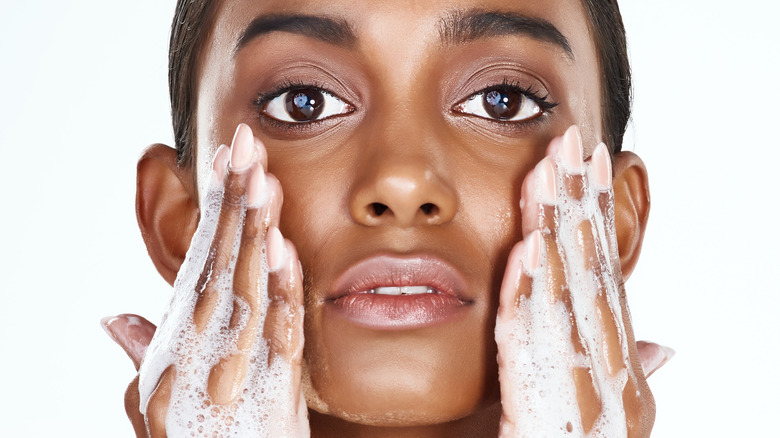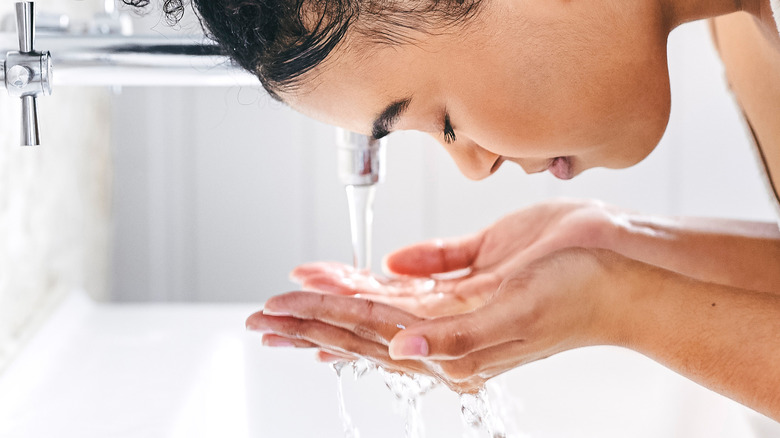Biphasic Cleansers May Put Your Double-Cleansing Routine To Shame - Here's How
Fans of K-Beauty are probably no strangers to the concept of double cleansing, which essentially means washing your face twice, per Healthline. To begin, an oil-based cleanser is used to remove oil-based contaminants such as makeup, skincare products, excess sebum, and pollutants. Then, you use a water-based cleanser that addresses your specific skin concerns to rinse away the dirt and grime that linger on the skin's surface, while also hydrating your skin. The goal of double cleansing is to make sure your skin is cleansed thoroughly, preventing dirt and product buildup that could lead to inflammation and breakouts.
Although double cleansing is beneficial for the skin, it's not the most suitable cleansing option for all skin types and certainly not ideal for the minimalists. If the idea of spring-cleaning your skin seems like a big ask, but you don't want to miss out on the benefit of a two-step cleansing technique either, say hello to biphasic cleansers. They might look like regular cleansers that cleanse and soothe your skin, but they're actually two steps merged into one. Here's why biphasic cleansers deserve a spot in your lazy-girl beauty routine.
What are biphasic cleansers?
Biphasic cleansers are the answer to the evergreen skincare conundrum that inspired double cleansing: the immiscibility of water and oil. Water and oil do not mix. Oils are hydrophobic, meaning they are repelled by water, and water cannot dissolve in oil. When you add oil to water, you'll see it floating on the surface instead of mixing with the water molecules. Oil cleansing and water cleansing should be done separately, as is the case with double cleansing. However, biphasic cleansers can kill two birds with one stone.
The dual-phase technology used in biphasic cleansers allows them to combine the aqueous phase and the oily phase for deep, effective cleansing, according to L'Oréal Paris. The oily phase is responsible for breaking down oil-based makeup and dirt. The aqueous phase, or the water-based portion of the formula, helps rinse away the excess impurities and residue to keep the skin feeling clean and smooth. Biphasic cleansers allow you to remove stubborn makeup and cleanse your skin's surface at the same time with just one product, without leaving a greasy residue. The lack of elbow grease required compared to double cleansing also helps preserve more natural oil in your skin. Due to their versatility, biphasic cleansers do a great job in taking the fuss out of skincare, especially if you're busy or forgetful. They're the perfect product for those who like to keep it simple. And using one product instead of two helps to cut down on bathroom counter clutter.
How to use biphasic cleansers
Biphasic cleansers can be found in a variety of forms, including mineral waters and foam cleansers. Some biphasic cleansers are specifically designed to remove makeup from the eyes and lips, while others are infused with exfoliating ingredients to further cleanse and brighten the skin.
When using a bi-phase cleanser, stir up the bottle to mix up the oil and water particles together. Then, apply the product to a cotton pad and spread it across your face to remove your makeup and skincare products. If your biphasic cleanser is in mineral water form, you don't have to rinse your skin with water afterwards. However, to ensure your face is completely sunscreen- and dirt-free, you can sweep it one last time with a cotton pad soaked in mineral water or toner.
If your biphasic cleanser is a cleansing milk, massage the formula into your face and emulsify with water before rinsing it off thoroughly. L'Oréal Paris' Classic Milky Cleansing Foam and Renée Rouleau's Better Than Balm are examples of biphasic cleansers that double as potent makeup removers. If you're wearing lots of makeup, it's better to use a foamy biphasic cleansing formula to ensure your skin gets an intensive cleanse.
If you've been prescribed a treatment cleanser for your specific skin concern, consult your dermatologist before switching to another one. Although biphasic cleansers make fantastic multitaskers, it's better to not try your luck when it comes to your skin health.


